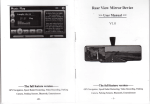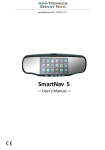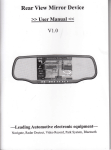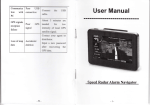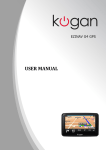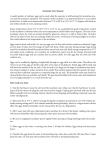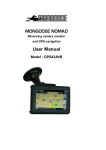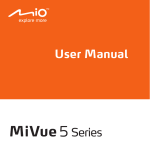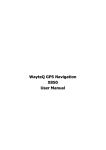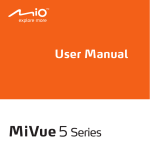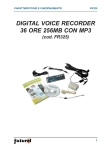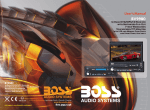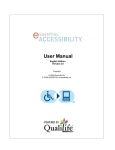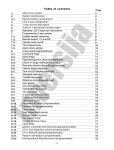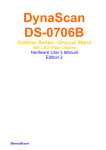Download Smart Nav Mirror 4.3
Transcript
www.app-tronics.com 1(888)587-4111 SmartNav 4.3 — User’s Manual — Welcome to SmartNav GPS. Please read this user’s manual carefully to become familiar with all the operation details and to ensure you use your device as it was designed. Before getting started, please note the following: • Specifications are subject to change without notice. • Please make a copy of the important data. • Please read the operating instruction carefully and use only accessories provided by the original manufacturer to avoid any unexpected damage. No warranty will be executed if you are not following the instructions or are connecting with incompatible accessories. We assume no responsibility for any loss or damage caused hereby. • The electronic navigation data may be not in conformity with the actual road markings due to traffic construction development. Please be sure to comply with actual road conditions and follow the traffic rules. • Operating and viewing the GPS while driving may cause a severe traffic accident. App-Tronics is not responsible for any loss caused by an unexpected accident. • Users can update and upgrade software by visiting www.app-tronics.com • The screens shown in this guide may be different than the ones you see on your device, depending on the firmware version. GPS Navigation, Speed Radar Dectecting, Video Recording, Parking Camera, Parking Sensors, Bluetooth, Entertainment -1- CONTENTS WELCOME CHAPTER I BEGINNING USE 1.1 Appearance 1.2 Installation 1.3 Basic Use 1.4 System Main Interface and Major Functions 1.5 Digital video recording* 1.6 Radar detecting 1.7 Parking radar and video CHAPTER II GPS 2.1 Map 2.2 Navigation with Speed Radar Alarm 2.3 Reception CHAPTER III INTERFACE AND OPERATION -2- Welcome 3 4 4 6 11 12 14 14 15 20 20 21 25 26 Thanks for using the device. With navigation as the major function, it supports GPS Navigation, Speed Radar Dectecting, Video Recording, Parking Camera, Parking Sensors, Bluetooth, Entertainment. You may use the GPS navigator anytime anywhere, for example while driving, walking or cycling. Its navigation and amusement functions will enrich your life and work! To fully exert the functions of the device and to understand the operation details, please read the manual carefully. You may see the following supplemental information in the manual. [Note]: Explanation of relevant subjects [Relevant Information]: Extra information of relevant subjects [Attention]: Precautions or warnings of relevant subjects. Please pay attention to this information and follow the instructions to avoid devastating influence on yourself and others. [*]: Optional function -3- Chapter I Beginning Use SN Component This chapter introduces the appearance, components and basic operations of the device. 1 1.1 Appearance The effect figure below is subject to the material object. LCD with The touch pannel is capacitive Touch panel 2 Cable Slot 3 Explanation Mounting bracket Vcc, GND,Video in, Parking Power, and Reversed Fixed the mirror device : Long push to power on/off . Sensitive 4 Buttons 8 buttons. : Switch displaying , , , , , :Used in recording video, please view 1.7.2. 5 TF card for DVR 6 Speaker 7 Speaker 8 Antenna 5 TF card Maps,video,music. Up to 32GB. 6 Speaker Playing sounds 7 Speaker Playing sounds 8 GPS antenna Built_in GPS antenna 9 Camera 9 DVR camera 10 Radar receive window 11 TF card for map -4- for recording -5- Detecting windows Receive and detecting the signal from the speed radar 11 Storage card TF card, record video, support up to 32GB. 10 Megapixels camera traffic video Install new mount to the base 1.2 Installation The following steps must be opereted by professional technicians of the vehicle. Step 1: Remove the original rearview mirror of the car matching from the front windshield; and then follow the reverse steps to properly install this product. Different models are supported by the rear-view mirror bracket,the following picture only show Honda cars. Remove original mount from the base -6- Step 2: Find out the ACC power connector. Most of the vehicles fuse box is basically installed in the following three positions: 1, The plaque , which is in the car hood on the driver's side. 2, The glove box, which is in front of Vice driver's seat. 3, The co-pilot air conditioning vent of the front foot In this process, it is important to note that the cut don’t fully grasp the situation, don,t make pull the fuse that would make unnecessary trouble - mistakenly lit the light of the failure of the vehicle (above operation by professional automotive technician or experience of the owners of operations, such as human errors cause this product to any failure, are excluded from the warranty -7- category). Step 3: Connecting cables on the front: 1, The power supply line (red line) is connectted to the ACC long power. 2, The negative wire (black line) is connectted to the public side of the fuse box, or closely connected to any metal parts in the body. 3, The reversing the signal line (blue line) is connectted to insurance box reversing power fuse. To ensure that wiring is correct, you can power on the car, if the rear-view mirror button backlight light, it means you have the correct wiring. Step 4: Alignment the line: All of the electrical connector with insulating black tape tied to prevent a short circuit or accidental loosening. Followed by demolition of interior parts: first remove the rubber seal, clawed through the roof and A-pillar trim, and then wire buried. Then has been good to connect the wires from the fuse box behind the leads into the A-pillar sealing strips along the body and then received through the roof in the windshield above the rearview mirror on. The same color cable sleeve or insulating tape wrapped. Finally, the trough will be sticking out of the harness buckle. Red line to ACC 12v Black line to GND Blue line to parking light 12V Yellow RCA to parking camera Step 5: Install the parking camera: 1) to find the install universal camera (or the appropriate location of the car with a special camera), if the punch camera camera insert hole saw hole after a fixed, if it is with butterfly screws. 2) directly from the reversing headlight lead, camera power supply line along the car taillight line placement, and tied with cable ties, parallel supply line (red positive, black negative) on the reversing light. Note that the distinction between positive and negative. 3) Carefully adjust the allowed reversing horizons to achieve the best results. Step 6: Install the parking sensors: -8- -9- 1) the probe horizontally mounted in the appropriate hole on the installation location, the best height of 50 to 60 cm, the spacing of the probe according to the number and installation location of the horizontal width. 2) reversing radar power supply line (red positive, black negative) in parallel with the reversing lights on. 3) Start the car and hang into the reverse parking sensor into operation, the car slowly retrogression to move in a certain object, the system will be able to detect and display the object distance, otherwise check the probe installed correctly. Parking camera Mirror Device Parking light power Parking light power ACC power Parking radar - 10 - 1.3 Basic Use 1.3.1 Powering on/off The device can automatically run when the car is start. Press the power key for at least two seconds can power it on or off. 1.3.2 Restarting the System When the system does not response, also can press the power key to restart the system. [Relevant Information] The following situations might lead to no response of the system. 1. Delay or stagnancy in interface switching; 2. Failure of function activation with overlong execution; 1.3.3 Using T-FLASH Card Copy mapping applications, map data and media files in a T-FLASH card. Insert the card in the corresponding slot. [Note] 1. Do not take out the T-FLASH card while an navigation program is being run or a media file is being played. 2. To avoid drop or crash of the T-FLASH card, do not exert heavy pressure on it or bend it. 3. Avoid using or storing the T-FLASH card in high temperature, high humidity or direct sunlight. Keep the card away from liquid or corrosive substance. - 11 - 4. Mind the direction while inserting the T-FLASH card to avoid damaging the slot or the card. 1.4 System Main Interface and Major Functions When power on the device, it will enter the system main interface shown below. - 12 - Unit The unit conversion Gps info Recorded signal Theme Theme settings Photo browser JPG,GIF,BMP and PNG files supported; Photo rotation, zoom in/out and auto play supported Explorer Go to the desktop Gobang Gobang games BoxMan BoxMan games Snake Snake games Nav path Navigation path specified Volume Set Volume Backlight Set backlight brightness Language Set Language Datetime Time and date settings Factoty Factoty Sys info Check the latest information Bluetooth Bluetooth setup operation 1.5 Parking sensors * Please view in the user manual of Parking sensors. 1.6 Parking camera* After the device runs on, it can display the reversing image When the car hanging into reverse. Click the upper left - 14 - The main functions are listed as below. Function Explanation Navigation Tap to enable navigation and detecting radar function Radar alarm Support X, K, KA,KU, New K, Laser band. Video recorder Support HD 720P video recording, built_in million pixel camera. Parking system Support the reversing camera and parking sensors input, display the image and distance on the screen Music player WMA9 and WAV files supported; Random, sequence and cycle supported Movie player WMV, ASF and AVI files supported; Adjustment of playing progress, pause and full-screen play supported E-book TXT files selection Flash SWF files supported; Wallpaper Set Desktop Wallpaper FM FM channel to adjust the power Calculator Units can be calculated reading supporting play page - 13 - corner of your display can flip the image, click on the screen the lower right corner to the upside down image. 1.7 Digital video recording* When the device run on, the system also auto start to recording video. The default display screen is WINCE. Tap to switch displaying wince and recording video. Click the upper left corner of your display can flip the image, click on the screen the lower right corner to the upside down image. 1.7.1 Features High-definition: Video Size can be set to high-definition HD 720P (1280x720/30FPS) or VGA (640x480/30FPS,). Continuous recording without interruption: The proprietary file format to reach without a break, do not reveal seconds continuous recording, and ensure not to miss any important scenes. Automatic cycle coverage: When the memory card is full, it will automatically overwrite the first image to start replication of new video clips. Lock important moment in the video: encountered a critical moment, press the latch button from the image within 60 seconds after pressing the moment of the first 60 seconds and will be locked preserved and not be - 15 - overwritten. Easy to use: do not need complex setting, used for the first just want to date and time set, and then start the engine automatically recording, stop recording after shutdown. Playback function: the movie itself has a display, you can preview the video screen and playback video clips. MJPG video format: each screen in the film are independent and complete real images, not H.264 or MPEG4 predict calculated from the screen, you can provide evidence of the most convincing image. Voice: support recording and playback. Storage media: requires the use of high-speed TF card, support for 4 ~ 32GB, video uses a proprietary file format, please SQPlayer or native formatted to use the memory card before use, and can not be used if there is no formatting. 1.7.2 Buttons define There are two mode: Record mode and Playback mode. Record Mode Button Define Recording Playback Mode Single In video Menu Show In Playing Stop REC / / In Menu Stop Playback Playback &Back to &Back Video Rec / to Video Rec MENU Stop Save Record & & Enter Stop Playback Menu,Back Enter Exit Menu & Enter Menu to Single Menu Menu Lock LOCK Video Size Stop &Enter OK** PLAY Time Setup Format TV Out 1280 x 720 YYYY/MM/DD HH:MM:SS Yes clip Audio Rec On/Off NTSC PAL On Description Set the video size to play Up clip* previus clip Down Next Go to play next clup* clip Down for menu Frequency Set date and time 50Hz Set the frequency of video 60Hz 1.7.5 System error message define Error Message Description Solution No Card Push in a card Dectect no card Card Protected Card is protected Card Error Unlock and push in Error occur when reading or Replace a new one writingthecard Card size too Size is smaller than 4GB,so Please use 4GB or small cann’t record larger not Card is not formatted yet,so Formot it firstly formatted Card cann’t record size Card size is changed cann’t record Sensor FAIL Sensor changed,so Please backup the data and format it. Initialize an Return to repair exception occurs,so cann’t record Set the fomat of TV out Protec slot full There is no room for more Unlock No Video Audio Record Off Set for recording audio Language English Set the language - 18 - Previous Go Up On/Off LCD OK* *: Now,if don’t release the button, it will go to previous or next untill release the button. **: When setting date or time, UP and DOWN can add/sub the value. PLAY can swith to next group,the order is Year, Month, Day, Hour, Minute,Second. When it is Second, click PLAY can save the setting and return tu the main menu. Format the TF card No video video playback mode DOWM / playback Pause/Continue Playback UP Unlock Start to Record Card 640 x 480 Unlock - 17 - /: No action. 1.7.3 Locked key explaination The system has kept 1GB room for locked video. It allow the users locked the video more than 3 times. When the locked button has been pushed, the system will auto storage 60 seconds previous and 60 seconds next 720P image(or 120seconds VGA) to the room. These video data cann’t be replaced. When the locked room is full, user can unlocked the old one in playback mode or through Sqplay tool. 1.7.4 Menu item define Sub Menu show / video clip - 16 - Main Menu Save &Exit some locked video playback mode No video Just to record - 19 - in 1.8 Speed radar detecting* Please ensure that there are no other obstacles (except the windshield) on the front of the radar receiver window.User can set parameters of the radar alarming on the setting screen. the software has built in the memory card (or local memory).If user use the replacementmemory card,please contact your dealer to authorize a new memory card ID to use. Before use the new version please operate that: Enter the route of \menu \ Settings \ navigation path, select the \ SDMMC \ P43_2 \ P43_2.EXE, double-click to save the path and exit. 2.2 Navigation with Speed Radar Alarm Tap function. to enable navigation and detecting radar Chapter II GPS Various navigation mapping applications can be installed in the GPS navigator, which position the navigator via the satellite receiver and display it on the map. Set a destination, and the system will automatically work out the best path to help the user reach the destination safely and quickly. 2.1 Map Due to transportation development, inconformity between products and real traffic information will occur a period after product release. Please drive according to road condition and abide by traffic regulations. - 20 - Tap - 21 - to add current position as a alarm camera location, you can choose which the type of the alarm camera is in the next windows. Name Traffic Lighting Camera Alarm Tap to delete the current position from the Spot alarm location list. Icon Explanation Traffice light Alarm on/ off Camera Alarm on/ off Display alarm tips on the upper left corner to enter navigation map. Navigation paths Display alarm tips on the upper rightcorner are for reference only, and the user may decide whether to follow them. Display alarm tips on the lower left corner Tap Display alarm tips on the lower right corner Tap to enter the setting menu, and set the value for speed radar detecting funtion. - 22 - - 23 - Preview Tap to set the navigation paths for A, B or C. When car speed is smallar than the value, The alarm does not prompt Speed of Silence Add the speed value Sub the speed value Navi A Select A as current excutived navi program, Navi A will display on title bar. Navi B Select B as current excutived navi program, Navi A will display on title bar. Navi C Select B as current excutived navi program, Navi A will display on title bar. Paths Specify the path navigation A, B, and C of Volume discrease Volume Volume increase 2.3 Reception High and crowded structures (such as inside of tunnels, space between high buildings, underground car parks and under viaducts), weather change or satellite signals turnoff may influence signal reception, resulting in positioning failure, inaccurate positioning, navigation failure or system function abnormity. With stereoscopic maps, instant animation, voice prompt and text prompt of the navigation system, you will appreciate its unique charm and enjoy a great trip. Different navigation maps may have different operation methods. Please follow instructions of corresponding navigation mapping applications. - 24 - - 25 - [Note] Before using the GPS navigator, please purchase and install mapping applications and appoint file paths. For setting methods please refer to 2.2 Setting Navigation Path. Chapter III Interface and Operation 3.1 Music Player Tap in the system main interface to enter the music interface as shown below. Icon Name Close Explanation Close the music player. - 26 - Minimize Minimize the music player and return to the Media interface. Play Continue playing the paused/ stopped music. Pause Pause the played. Stop Stop the music being played. Set play sequence Select sequence, random or cycle play. Previous Play the previous music. Next Play the next music. Volume Drag it leftward to turn down or rightward to turn up the volume. Progress Drag it leftward or rightward to play from a previous or future moment. Music list Enter it to select music to play. Time Display the run time. Equalizer Enter the equalizer. - 27 - music being Tap in the interface Music Play to enter the Music list shown as below. 3.2 Movie Player Tap Icon Name in the video player interface shown as below.、 Explanation Close Close the Music List Scroll bar Drag it upward/ downward to view all music. Add one Add a piece of music on the left list to the play list on the right. Add all Add all the music on the left list to the play list on the right. Delete one Select one piece of music in the play list and tap the icon to delete it. Delete all Delete all the music in the play list. Icon Name Close Close the video player. Previous film Play the previous film. Play Continue playing the paused/ stopped music. Next film Play the next film. Stop Stop the film being played. Video folder Enter it to select a film to play. - 28 - Progress Volume Time Explanation - 29 - Drag the sliding block leftward to play from a previous moment or rightward coming moment. Scroll bar Film name& format Drag it leftward to turn down or rightward to turn up the volume. 3.4 E-book Reader Display the play time and the music duration. Tap Drag the sliding block upward/ downward to view all the files inside the folder. Film name and its format in the Media interface to enter the reader interface shown as below. Tap in the Video Player interface to enter the video folder shown as below. Icon Icon Name Close Explanation Close the video folder. Name File name& Current file name and format format. Close - 30 - Explanation Close the reader. - 31 - Scroll bar Drag the sliding block upward/ downward to view all content of the e-book. Folder Enter the e-book folder to select an e-book to read. Previous Read the previous page. Next Read the next page. Setting Select a text theme, font, word size and bold type. New bookmark Select partial text and tap the icon to create a bookmark. Bookmark list Enter the bookmark list to select or delete a bookmark. Page/ total pages Tap in the e-book reader interface to enter the setting interface shown as below. Icon Name Current page/ total pages Explanation Close Exit the setting interface Save Save the setting. Theme Tap to select a theme for the e-book. Font Tap to select a font for the e-book. Bold Tap to enable bold type. Tap it again to cancel. Tap in the e-book reader interface to enter the e-book folder shown as below. - 32 - - 33 - Tap to view created bookmarks in the interface of Bookmark List shown as below. Icon Name Close Explanation Close current folder. Drag the scroll bar and select a bookmark on the left list. Return Return to the previous folder. Scroll bar Drag the sliding block upward/ downward to view all TXT files. File name& format Tap to go to the page with the bookmark or tap to delete the bookmark. 3.5 Flash player The file name and format. Tap below. To create a bookmark, locate a page by taping in the Flash player or or dragging the scroll bar in the reader interface and drag to select text content. Tap to finish. - 34 - when it is on. Tap OK - 35 - interface shown as 3.6 Wallpaper Tap in the Wallpaper interface shown as below. Close Exit the FM Setting. Save Save current setting. Use FM Tick in the box to enable FM function. Frequ ency Drag the slide block rightward (or tap ) to increase the frequency and leftward (or tap ) to reduce the frequency. The frequency range is 88.00 Mhz-108.00 Mhz. 3.9 Calculator 3.8 FM Tap in the FM interface shown as below. Tap in the Calculator interface shown as below. - 36 - - 37 - 3.12 GPS info Tap in the GPS info interface shown as below. 3.10 Unit Tap in the Unit interface shown as below. Tap - 38 - to prompt a dialog as below. - 39 - Tap OK to reset the GPS satellite or tap Cancel to exit. 3.13 Theme Tap in the Theme interface shown as below. Icon 3.14 Photo Browser Tap in the photo browser interface shown as Name Explanation Previous View the preview photo in the folder. Next View the next photo in the folder. Zoom in Scale up current photo. Zoom out Scale down current photo. Rotate Rotate current photo 90°clockwise. Auto play Cycle play all the photos in the folder from current photo. Folder Enter the photo folder to select a photo. Close Close the browser and return to the Media interface. below. - 40 - - 41 - Tap in the browser interface to enter the photo folder shown as below. Icon Name Explanation Close Close the current folder. Return Return to the previous folder. Scroll bar Drag the sliding block to view all the photos. 3.16 Gobang 3.15 Explore Tap Tap in the Gobang interface shown as below. in the Explore interface shown as below. - 42 - - 43 - 3.18 Nav path Tap in the photo browser interface shown as below. 3.17 Snake Tap in the Snake interface shown as below. Select a map address and tap to save the setting. Tap to select a map address. Tick in the box to run the set navigation map when the navigator is powered on. 3.19 Volune Tap in the photo browser interface shown as below. - 44 - Close Exit the volume setting. Volume Ten volume grades (from mute to maximum) available. Tap to decrease the volume by grade. Sounds for taps Tap it to enable the function. Tap it again to disable the function. Power-o n music Tap or to select power-on music or disable it. - 45 - Exit the backlight setting. Backl ight Drag leftward to turn down or rightward to turn up the backlight. Auto off Auto backlight shutoff after service stop for a period. The options are always On, 10s, 30s, 1m, 2m and 3m. Tap or to view the options in cycle or select one. 3.21 Language 3.20 Backlight Tap Tap Close in the photo browser interface shown as below. in the photo browser interface shown as below. - 46 - - 47 - In the above interface, tap or to set the year, month, day, hour and minute. [Note]: Time format options are 12-hour and 24-hour. Setting the system time zone In the above interface, tap or to select a time zone. For example, select “(GMT+08:00) Beijing, Chongqing, Hong Kong, Urumqi” for China. 3.23 Sys info Tap or to select a system language and tap save the selection. to Tap in the photo browser interface shown as below. 3.22 Date time Tap in the photo browser interface shown as below. 3.24 Bluetooth Setting the system date and time Tap in the Bluetooth interface shown as below. - 48 - Tap in the Search interface shown as below. - 49 - Tap in the To connect a Bluetooth interface shown as below. - 50 - - 51 - Tap Tap outgoing call Tap Phone Keyboard in the PhoneBook interface shown as below. Tap Click interface for access to the phone the following figure shown. - 52 - Tap - 53 - Phone Keyboard Tap Keyboard Incoming call - 54 - - 55 - Tap Tap Visit the website Tap Select the network state Selection asked whether using a mobile phone to access the network, Select "Yes", then as shown. Tap Bluetooth settings - 56 - - 57 - Click on the icon Click on the icon Click on the icon , to access music , and disconnected - 58 - - 59 - ——The full feature version—— GPS Navigation, Speed Radar Dectecting, Video Recording, Parking Camera, Parking Sensors, Bluetooth, Entertainment -60-


















